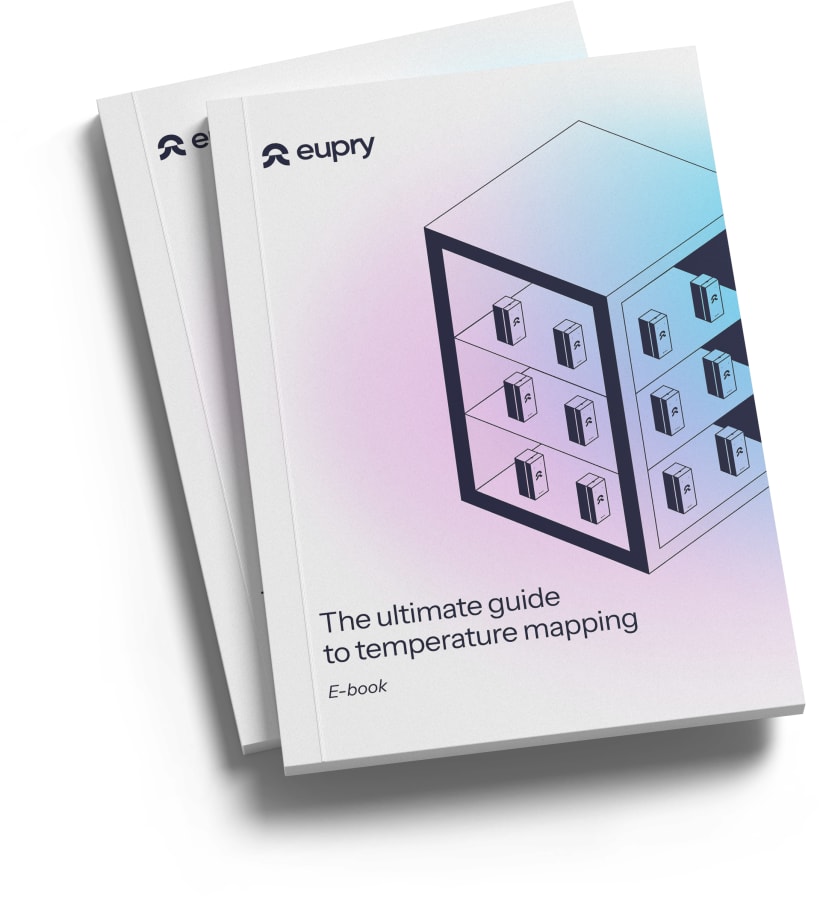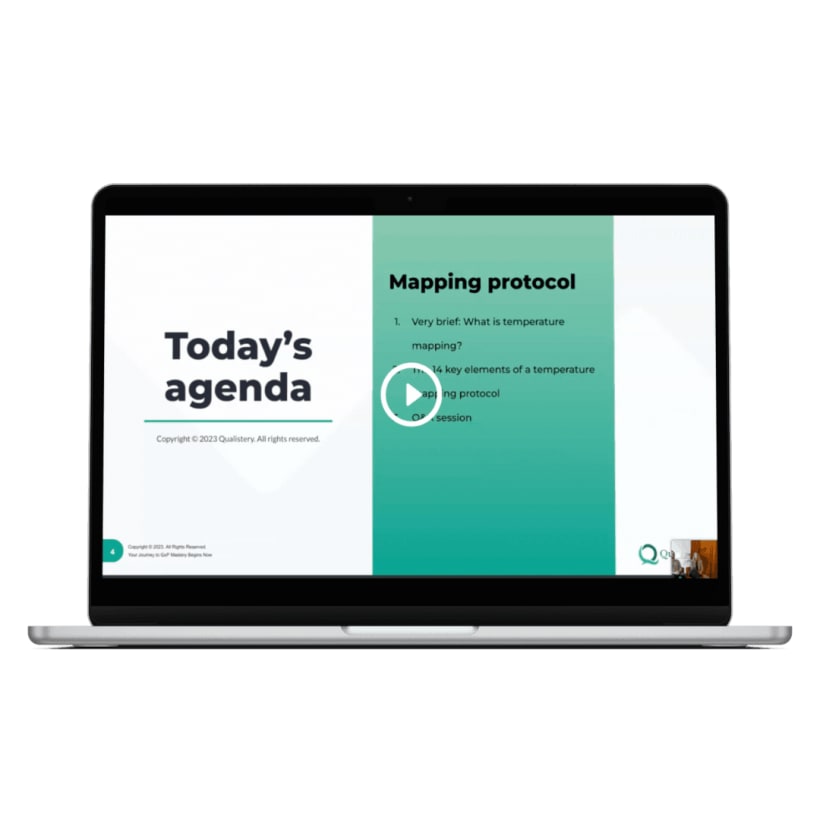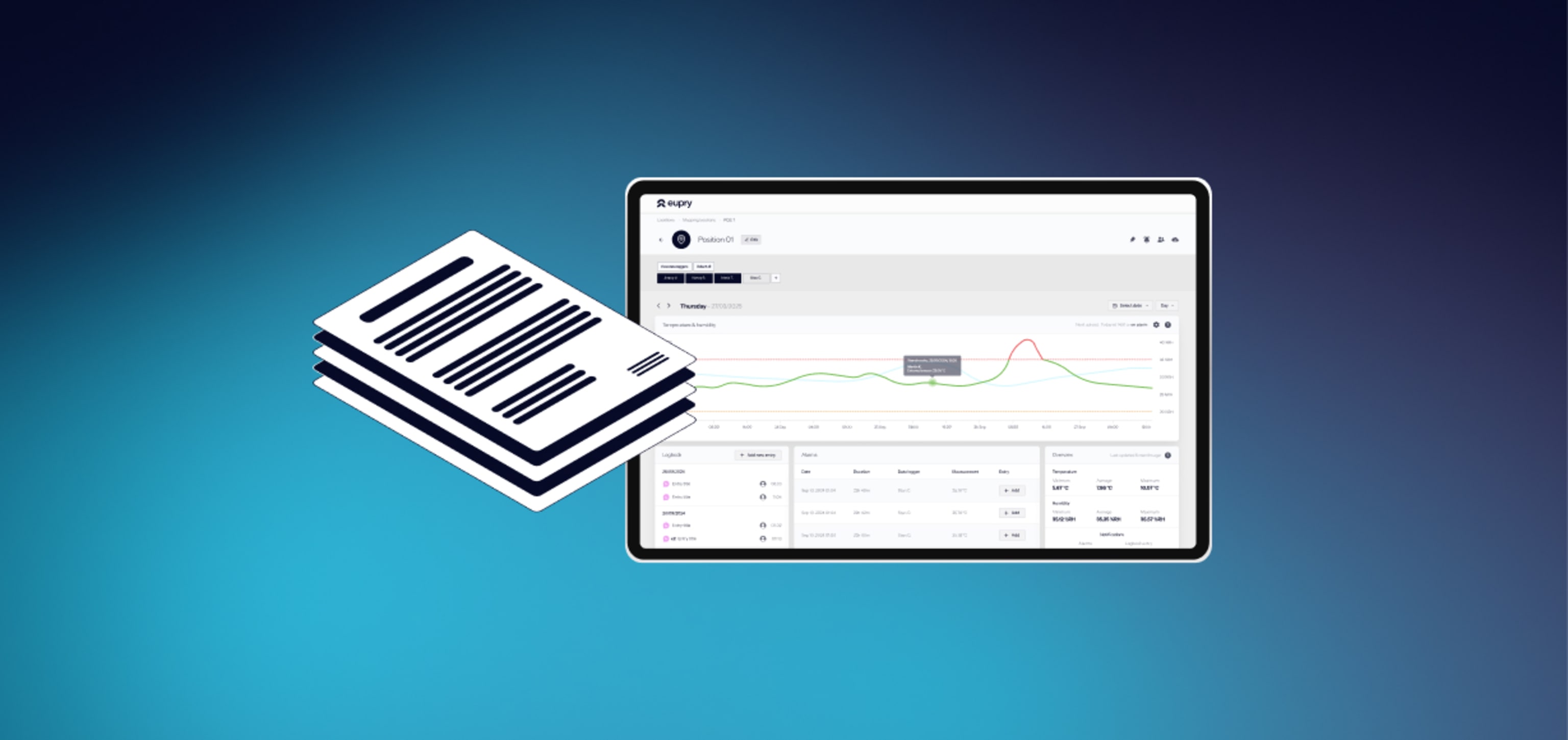
How to create a temperature mapping protocol in pharma
Athina Magklara

Estimated reading time: 6 minutes
Everything you need to know to design a compliant and effective mapping protocol in pharma, healthcare logistics, and other GxP-regulated industries that will save you both time and headache.
The article goes through:
Also read: How to perform effective mapping in GxP
What should your mapping protocol contain in GxP?
A straightforward and easy-to-understand protocol will help ensure that the temperature mapping study is carried out correctly. A standard protocol guideline can be used to map any facility and equipment.
The protocol typically contains the following sections:
- Approval page
- Acronyms and glossary
- References
- Roles and responsibilities
- Purpose
- Description of equipment/facility
- Scope
- Objectives
- Acceptance criteria
- Risk assessment
- Methodology
- Data analysis and reporting
- Non-conformities
- Change history

Complete mapping guide
Navigate your next study confidently by following this 5-step guide.
Approval page
The approval page of a mapping protocol typically includes signatures or formal acknowledgments from responsible individuals within the organization commissioning the mapping. The page confirms that these individuals have reviewed and approved the protocol.
Additionally, this page often grants the final authority for approval to the customer, ensuring that all parties agree on the mapping procedures and objectives. The customer has the final authority for the approval, and the protocol is approved when the customer signs the approval page.
Acronyms and glossary
Definition of the acronyms and technical terms used in the protocol. The goal is to create clarity and a shared understanding of the terminology used in the protocol.
References
This includes references to mapping guidelines, customer URS (User Requirement Specifications), test plans, and other mentioned documents.
Roles and responsibilities
Identification of the commissions and roles of responsible persons, including the qualified third party, original author, reviewer, approver, and tester.
Purpose
This outlines the reasoning for the mapping, establishing the importance and objectives of the exercise.
Description of the unit
The equipment or facility to be mapped must be described in order to propose the placement of the data loggers and the assessment of risks. The description is often unique for the unit to be mapped, and the organization provides information and details of the equipment or facility.
The rationale of the placements is to describe the installation and the outline for carrying out the mapping study. Often drawings are used to show elements, such as shelving, pallet racket, doors, windows, and the layout of the unit to be mapped.
Also read: Guide: How to choose the right temperature mapping equipment
Scope
The scope covers what will be done for the mapping.
It meticulously defines the boundaries of the area or equipment to be mapped and rationalizes the extent of the mapping process, considering factors like equipment size, usage, and environmental conditions. This section also details what specific elements will be covered, such as different zones within a facility, temperature variations, and potential risk areas.
By clearly outlining these aspects, the scope ensures that the mapping exercise is comprehensive, targeted, and tailored to the specific needs of the environment being assessed.
Preferably, at least two temperature mapping studies are performed, to observe the effect of seasonal variation. This can provide evidence that the mapped area can maintain stable temperature throughout the year.
Objectives
The objectives of the mapping is different from every mapping scenario, however it is often:
-
Mapping of temperature variations in selected areas, typically freezer rooms, cold rooms, warehouses, packing areas, trailers and other areas where TTSA are stored or temporarily held.
-
Document cold and hot spots caused by temperature controlled systems and environmental impact at the time of the study.
-
Measure the time taken for any excursions from tests such as placing goods, door openings and power failures.
-
Identifying the placements for fixed temperature monitoring. If the monitoring system is already installed, then identify the best places for re-location of the temperature loggers (if needed).
-
Recommendations for actions needed to overcome the issues identified in the study.
Also read: The who, what, and how of temperature mapping training
Acceptance criteria
Acceptance criterias are usually identified by the customer, URS or national requirements. The acceptance criteria are typically:
- Compliance temperature within certain temperature range
- Measure the temperature distribution for an overview of possible placement of TTSA.
If the mapping study is not in compliance with the acceptance criterias then it can be assessed that the mapped unit is not compliant to store goods.
Risk assessment
When performing mappings potential threats are identified in the risk assessment. These risks are different for each mapped unit and also the tests to be performed. The most often risk assessments are conducted from internal and external influences of the unit to be mapped.
Methodology
The methodology section usually is the largest section in the mapping protocol, as it covers requirements of the test equipment, determination of the placement of loggers and how the mapping tests are performed.
Requirements and identification of Eupry EDLMs
- Eupry data loggers comes with a external temperature sensor (probe)
- All temperature sensors are calibrated in 3-points, and validated with a certificate.
- The temperature sensors have an error of no more than ± 0.5°C.
- Calibrationshould be done annually with a fixed monitoring system.
Determination of the placement of EDLMs
The placements of the data loggers are usually done in a grid matter to cover all areas to be mapped. The placements of loggers must be placed as guided in the protocol, if this is not the case some placements are defined as non-confirmant.
Tests to be performed
The tests to be carried out are requested by the organization, and are explained in a straightforward manner, to gain an overview for the organization when conducting both remote and on-site mappings.
Data analysis and reporting
Outlining how to handle data analysis and reporting already in the temperature mapping protocol helps predefine how collected data will be processed and presented, ensuring clarity and consistency in the approach and that this can be taken into account during collection.
This section sets the expectations for analyzing findings, guiding how data will be interpreted and documented. By specifying this in the protocol, you establish a clear methodology for data handling, which aids in efficient analysis and helps in deriving meaningful conclusions from the study, ultimately ensuring that the results are accurate, reliable, and useful for decision-making.
Non-conformities
In the non-conformities section, the handling of non-conformities is defined.
Because non-conformities will happen. How to handle them? Who is responsible for management? Who should accept it? And how much can go wrong before a new mapping study has to be performed?
Change history
The change history covers the different revisions of the protocol. The revisions include the initials of the person who made the changes, the date of the change, and comments on what has been changed.
Who should be involved in creating your protocol?
Designing a temperature mapping protocol should involve a collaborative effort from various people.
This would typically be:
- Quality Assurance (QA) professionals to ensure compliance with regulatory standards.
- Facility or equipment managers who understand the specific environmental conditions and operational nuances.
- Engineering or technical experts for insights on equipment functionality and environmental control systems.
- Data analysts for designing the data collection and analysis methodology.
- External consultants or other validation experts, especially when specialized knowledge or third-party validation is needed.
- This multidisciplinary approach ensures that the protocol is comprehensive, practical, and aligned with both regulatory requirements and the specific needs of the facility or equipment being mapped.
Also read: 4 key players you should include in your temperature mapping study

Learning session: 14 elements of a reliable mapping protocol for GxP
Watch videoReferences: WHO Technical Report Series No. 961, 2011, Annex 9: Model guidance for the storage and transport of time- and temperature-sensitive pharmaceutical products.
Also read: The key regulations and standards relevant for mapping



